Degradation of the In-plane Shear Modulus of Structural BFRP Laminates Due to High Temperature
Abstract
:1. Introduction
2. Derivations of the In-plane Shear Modulus
2.1. E1, E2, and ν21
2.2. Shear Modulus G12 by the 45° Off-Axis Tension Tests
3. Experimental Program
3.1. Instrumentation and Measuring System for the High-Temperature Tests
3.2. Specimen Design and Preparation
- (a)
- Generate random two-dimensional coordinates of points in the X-Y plane. The density and distribution of the speckles can be controlled by computer.
- (b)
- Assign a radius to each speckle point, and the size of the speckles can be controlled by computer.
- (c)
- Generate a computer-generated speckle pattern by using the two-dimensional coordinates of random points and the radius of the speckles.
- (d)
- Import the computer-generated speckle pattern into the specially designed fiber laser engraving system.
- (e)
- By adjusting the output power and exposure time of the fiber laser engraving system, a laser-engraved speckle pattern can be created. The depth of the speckle pattern can be controlled by computer.
3.3. Testing
4. Test Results and Discussion
5. Conclusions
- (1)
- The derivations illustrated that the in-plane shear modulus can be calculated from four other mechanical parameters (i.e., E1, E2, ν21 and E45). These four parameters can be directly obtained in an experimental program including both uniaxial tension and off-axis tension tests. The newly developed testing and measuring system with DIC was successfully used to accurately measure the mechanical properties of the BFRP specimens.
- (2)
- The elastic moduli of the BFRP laminates in three directions, E1, E2 and E45, from direct test results, together with the in-plane shear modulus calculated by the analytical formulas, drop to a very low level from 20 to 250 °C. The values of E45 and G12 decrease more rapidly (with 8.7% and 3.0% of those at 20 °C, respectively) than E1 and E2 at 250 °C.
- (3)
- The degradation of mechanical performances due to high temperature is because of the decomposition of the epoxy resin matrix with increasing temperatures. Internal debonding occurs in the fibers due to the weak adhesion of epoxy resin matrix at high temperature.
- (4)
- The low level of the shear modulus, as well as other mechanical behaviors, of BFRP laminates at high temperatures show the need for the improvement on the thermal behavior for the wide applications using this composite material in the future.
Author Contributions
Funding
Acknowledgments
Conflicts of Interest
References
- Holbery, J.; Houston, D. Natural-fiber-reinforced polymer composites in automotive applications. J. Miner. Met. Mater. Soc. 2006, 58, 80–86. [Google Scholar] [CrossRef]
- Dlugosch, M.; Volk, M.; Lukaszewicz, D.; Fritsch, J.; Hiermaier, S. Suitability assessments for advanced composite-metal hybrid material systems in automotive crash structural applications. Int. J. Automot. Compos. 2017, 3, 14–28. [Google Scholar] [CrossRef]
- Giannopoulos, I.K.; Doroni-Dawes, D.; Kourousis, K.I.; Yasaee, M. Effects of bolt torque tightening on the strength and fatigue life of airframe FRP laminate bolted joints. Compos. Part B Eng. 2017, 125, 19–26. [Google Scholar] [CrossRef]
- Bakis, C.E.; Bank, L.C.; Brown, V.; Cosenza, E.; Davalos, J.; Lesko, J.; Machida, A.; Rizkalla, S.; Triantafillou, T. Fiber-reinforced polymer composites for construction—State-of-the-art review. J. Compos. Constr. 2002, 6, 73–87. [Google Scholar] [CrossRef]
- Zhang, D.M.; Gu, X.L.; Yu, Q.Q.; Huang, H.; Wan, B.; Jiang, C. Fully probabilistic analysis of FRP-to-concrete bonded joints considering model uncertainty. Compos. Struct. 2018, 185, 786–806. [Google Scholar] [CrossRef]
- Jiang, C.; Yuan, F.; Wu, Y.F.; Zhao, X.M. Effect of interfacial bond on the plastic hinge length of FRP confined RC columns. J. Compos. Constr. 2019, in press. [Google Scholar]
- Cao, Y.G.; Wu, Y.F.; Jiang, C. Stress-strain relationship of FRP confined concrete columns under combined axial load and bending moment. Compos. Part B Eng. 2018, 134, 207–217. [Google Scholar] [CrossRef]
- Wan, B.; Jiang, C.; Wu, Y.F. Effect of defects in externally bonded FRP reinforced concrete. Constr. Build. Mater. 2018, 172, 63–76. [Google Scholar] [CrossRef]
- Jiang, C.; Wu, Y.F.; Dai, M.J. Degradation of steel-to-concrete bond due to corrosion. Constr. Build. Mater. 2018, 158, 1073–1080. [Google Scholar] [CrossRef]
- Qin, R.; Zhou, A.; Lau, D. Effect of reinforcement ratio on the flexural performance of hybrid FRP reinforced concrete beams. Compos. Part B Eng. 2017, 108, 200–209. [Google Scholar] [CrossRef]
- Ballinger, C.; Smith, W. Structural FRP composites. In Civil Engineering; American Society of Civil Engineers: Reston, VI, USA, 1990; pp. 63–65. [Google Scholar]
- Wu, Z.S.; Wang, X.; Wu, G. Basalt FRP composite as reinforcements in infrastructure. In Proceedings of the 17th Annual International Conference on Composites/Nano Engineering (ICCE-17), Waikiki, HI, USA, 26 July–1 August 2009; pp. 21–24. [Google Scholar]
- Wang, Z.; Zhao, X.L.; Xian, G.; Wu, G.; Raman, R.S.; Al-Saadi, S.; Haque, A. Long-term durability of basalt-and glass-fibre reinforced polymer (BFRP/GFRP) bars in seawater and sea sand concrete environment. Constr. Build. Mater. 2017, 139, 467–489. [Google Scholar] [CrossRef]
- Tang, Y.; Wu, Z.S. Distributed long-gauge optical fiber sensors based self-sensing FRP bar for concrete structure. Sensors 2016, 16, 286. [Google Scholar] [CrossRef] [PubMed]
- Dong, Z.; Wu, G.; Zhao, X.L.; Wang, Z.K. A refined prediction method for the long-term performance of BFRP bars serviced in field environments. Constr. Build. Mater. 2017, 155, 1072–1080. [Google Scholar] [CrossRef]
- Shi, J.; Wang, X.; Wu, Z.S.; Zhu, Z. Creep behavior enhancement of a basalt fiber-reinforced polymer tendon. Constr. Build. Mater. 2015, 94, 750–757. [Google Scholar] [CrossRef]
- Ansari, M.M.; Chakrabarti, A. Progressive damage of GFRP composite plate under ballistic impact: Experimental and numerical study. Polym. Polym. Compos. 2016, 24, 579–585. [Google Scholar] [CrossRef]
- Totry, E.; González, C.; LLorca, J.; Molina-Aldareguía, J.M. Mechanisms of shear deformation in fiber-reinforced polymers: Experiments and simulations. Int. J. Fract. 2009, 158, 197–209. [Google Scholar] [CrossRef]
- Xiang, Y.; Fang, Z.; Wang, C.; Zhang, Y.; Fang, Y. Experimental investigations on impact behavior of CFRP cables under pretension. J. Compos. Constr. 2016, 21, 04016087. [Google Scholar] [CrossRef]
- Zhou, A.; Tam, L.H.; Yu, Z.; Lau, D. Effect of moisture on the mechanical properties of CFRP–wood composite: An experimental and atomistic investigation. Compos. Part B Eng. 2015, 71, 63–73. [Google Scholar] [CrossRef]
- Yu, Q.Q.; Wu, Y.F. Fatigue durability of cracked steel beams retrofitted with high-strength materials. Constr. Build. Mater. 2017, 155, 1188–1197. [Google Scholar] [CrossRef]
- Wu, Y.F.; Xu, X.S.; Sun, J.B.; Jiang, C. Analytical solution for the bond strength of externally bonded reinforcement. Compos. Struct. 2012, 94, 3232–3239. [Google Scholar] [CrossRef]
- Cao, Y.G.; Jiang, C.; Wu, Y.F. Cross-sectional unification on the stress-strain model of concrete subjected to high passive confinement by fiber-reinforced polymer. Polymers 2016, 8, 186. [Google Scholar] [CrossRef]
- Bai, Y.; Keller, T.; Vallée, T. Modeling of stiffness of FRP composites under elevated and high temperatures. Compos. Sci. Technol. 2008, 68, 3099–3106. [Google Scholar] [CrossRef]
- Chowdhury, E.; Eedson, R.; Bisby, L.; Green, M.; Benichou, N. Mechanical characterization of fibre reinforced polymers materials at high temperature. Fire Technol. 2011, 47, 1063–1080. [Google Scholar] [CrossRef]
- Mahato, K.K.; Dutta, K.; Ray, B.C. High-temperature tensile behavior at different crosshead speeds during loading of glass fiber-reinforced polymer composites. J. Appl. Polym. Sci. 2017, 134, 44715. [Google Scholar] [CrossRef]
- Im, K.H.; Cha, C.S.; Kim, S.K.; Yang, I.Y. Effects of temperature on impact damages in CFRP composite laminates. Compos. Part B Eng. 2001, 32, 669–682. [Google Scholar] [CrossRef]
- Kobayashi, S.; Terada, K.; Takeda, N. Evaluation of long-term durability in high temperature resistant CFRP laminates under thermal fatigue loading. Compos. Part B Eng. 2003, 34, 753–759. [Google Scholar] [CrossRef]
- Cao, S.; Wu, Z.S.; Wang, X. Tensile properties of CFRP and hybrid FRP composites at elevated temperatures. J. Compos. Mater. 2009, 43, 315–330. [Google Scholar]
- Cao, S.; Wang, X.; Wu, Z.S. Evaluation and prediction of temperature-dependent tensile strength of unidirectional carbon fiber-reinforced polymer composites. J. Reinf. Plast. Compos. 2011, 30, 799–807. [Google Scholar]
- Saadatmanesh, H.; Tannous, F.E. Long-term behavior of aramid fiber reinforced plastic (AFRP) tendons. ACI Mater. J. 1999, 96, 297–305. [Google Scholar]
- Wei, B.; Cao, H.; Song, S. Tensile behavior contrast of basalt and glass fibers after chemical treatment. Mater. Des. 2010, 31, 4244–4250. [Google Scholar] [CrossRef]
- Lu, Z.; Xian, G.; Li, H. Experimental study on the mechanical properties of basalt fibres and pultruded BFRP plates at elevated temperatures. Polym. Polym. Compos. 2015, 23, 277. [Google Scholar] [CrossRef]
- Lu, Z.; Xian, G.; Li, H. Effects of thermal aging on the water uptake behavior of pultruded BFRP plates. Polym. Degrad. Stab. 2014, 110, 216–224. [Google Scholar] [CrossRef]
- Lu, Z.; Xian, G.; Li, H. Effects of elevated temperatures on the mechanical properties of basalt fibers and BFRP plates. Constr. Build. Mater. 2016, 127, 1029–1036. [Google Scholar] [CrossRef]
- Zhou, A.; Büyüköztürk, O.; Lau, D. Debonding of concrete-epoxy interface under the coupled effect of moisture and sustained load. Cem. Concr. Compos. 2017, 80, 287–297. [Google Scholar] [CrossRef]
- Wu, L.; Hoa, S.V.; Ton-That, M.T. Effects of water on the curing and properties of epoxy adhesive used for bonding FRP composite sheet to concrete. J. Appl. Polym. Sci. 2004, 92, 2261–2268. [Google Scholar] [CrossRef]
- Stratford, T.J.; Bisby, L.A. Effect of warm temperatures on externally bonded FRP strengthening. J. Compos. Constr. 2011, 16, 235–244. [Google Scholar] [CrossRef]
- Naya, F.; González, C.; Lopes, C.S.; Van der Veen, S.; Pons, F. Computational micromechanics of the transverse and shear behavior of unidirectional fiber reinforced polymers including environmental effects. Compos. Part A Appl. Sci. Manuf. 2017, 92, 146–157. [Google Scholar] [CrossRef]
- Mehdikhani, M.; Aravand, M.; Sabuncuoglu, B.; Callens, M.G.; Lomov, S.V.; Gorbatikh, L. Full-field strain measurements at the micro-scale in fiber-reinforced composites using digital image correlation. Compos. Struct. 2016, 140, 192–201. [Google Scholar] [CrossRef]
- Canal, L.P.; González, C.; Molina-Aldareguía, J.M.; Segurado, J.; LLorca, J. Application of digital image correlation at the microscale in fiber-reinforced composites. Compos. Part A Appl. Sci. Manuf. 2012, 43, 1630–1638. [Google Scholar] [CrossRef] [Green Version]
- Scalici, T.; Fiore, V.; Orlando, G.; Valenza, A. A DIC-based study of flexural behaviour of roving/mat/roving pultruded composites. Compos. Struct. 2015, 131, 82–89. [Google Scholar] [CrossRef]
- Sideridis, E. The in-plane shear modulus of fibre reinforced composites as defined by the concept of interphase. Compos. Sci. Technol. 1988, 31, 35–53. [Google Scholar] [CrossRef]
- Wu, Y.F.; Jiang, J.F. Effective strain of FRP for confined circular concrete columns. Compos. Struct. 2013, 95, 479–491. [Google Scholar] [CrossRef]
- Zheng, B.; Dawood, M. Debonding of carbon fiber–reinforced polymer patches from cracked steel elements under fatigue loading. J. Compos. Constr. 2016, 20, 04016038. [Google Scholar] [CrossRef]
- Ilki, A.; Peker, O.; Karamuk, E.; Demir, C.; Kumbasar, N. FRP retrofit of low and medium strength circular and rectangular reinforced concrete columns. J. Mater. Civ. Eng. 2008, 20, 169–188. [Google Scholar] [CrossRef]
- Nerilli, F.; Vairo, G. Experimental investigation on the debonding failure mode of basalt-based FRP sheets from concrete. Compos. Part B Eng. 2018, 153, 205–216. [Google Scholar] [CrossRef]
- Qiao, P.; Davalos, J.F.; Brown, B. A systematic analysis and design approach for single-span FRP deck/stringer bridges. Compos. Part B Eng. 2000, 31, 593–609. [Google Scholar] [CrossRef]
- Chen, J.F.; Li, S.Q.; Bisby, L.A.; Ai, J. FRP rupture strains in the split-disk test. Compos. Part B Eng. 2011, 42, 962–972. [Google Scholar] [CrossRef]
- Malek, A.M.; Saadatmanesh, H. Analytical study of reinforced concrete beams strengthened with web-bonded fiber reinforced plastic plates or fabrics. ACI Struct. J. 1998, 95, 343–352. [Google Scholar]
- Amoushahi, H.; Azhari, M. Buckling of composite FRP structural plates using the complex finite strip method. Compos. Struct. 2009, 90, 92–99. [Google Scholar] [CrossRef]
- Maimi, P.; Mayugo, J.A.; Camanho, P.P. A three-dimensional damage model for transversely isotropic composite laminates. J. Compos. Mater. 2008, 42, 2717–2745. [Google Scholar] [CrossRef]
- Zhao, X.; Wang, X.; Wu, Z.S.; Keller, T.; Vassilopoulos, A.P. Temperature effect on fatigue behavior of basalt fiber-reinforced polymer composites. Polym. Compos. 2018, in press. [Google Scholar] [CrossRef]
- Standardization Administration of China. GB/T 1447-2005. Fiber-Reinforced Plastics Composites—Determination of Tensile Properties; Standardization Administration of China: Beijing, China, 2005.
- Wu, Y.F.; Jiang, C. Effect of load eccentricity on the stress–strain relationship of FRP-confined concrete columns. Compos. Struct. 2013, 98, 228–241. [Google Scholar] [CrossRef]
- Nanni, A.; Bradford, N.M. FRP jacketed concrete under uniaxial compression. Constr. Build. Mater. 1995, 9, 115–124. [Google Scholar] [CrossRef]
- Ozbakkaloglu, T.; Akin, E. Behavior of FRP-confined normal-and high-strength concrete under cyclic axial compression. J. Compos. Constr. 2011, 16, 451–463. [Google Scholar] [CrossRef]
- Li, P.; Wu, Y.F.; Gravina, R. Cyclic response of FRP-confined concrete with post-peak strain softening behavior. Constr. Build. Mater. 2016, 123, 814–828. [Google Scholar] [CrossRef]
- Li, P.; Wu, Y.F. Stress–strain behavior of actively and passively confined concrete under cyclic axial load. Compos. Struct. 2016, 149, 369–384. [Google Scholar] [CrossRef]
- Zhou, A.; Qin, R.; Feo, L.; Penna, R.; Lau, D. Investigation on interfacial defect criticality of FRP-bonded concrete beams. Compos. Part B Eng. 2017, 113, 80–90. [Google Scholar] [CrossRef]
- Jiang, C.; Wu, Y.F.; Wu, G. Plastic hinge length of FRP-confined square RC columns. J. Compos. Constr. 2014, 18, 04014003. [Google Scholar] [CrossRef]
- Wu, Y.F.; Jiang, C. Quantification of bond-slip relationship for externally bonded FRP-to-concrete joints. J. Compos. Constr. 2013, 17, 673–686. [Google Scholar] [CrossRef]
- Guan, D.; Jiang, C.; Guo, Z.; Ge, H. Development and seismic behavior of precast concrete beam-to-column connections. J. Earthq. Eng. 2018, 22, 234–256. [Google Scholar] [CrossRef]
- Yu, Q.Q.; Wu, Y.F. Fatigue Strengthening of Cracked steel beams with different configurations and materials. J. Compos. Constr. 2016, 21, 04016093. [Google Scholar] [CrossRef]
- Jiang, C.; Wu, Y.F.; Jiang, J.F. Effect of aggregate size on stress-strain behavior of concrete confined by fiber composites. Compos. Struct. 2017, 168, 851–862. [Google Scholar] [CrossRef]
- Guan, D.; Guo, Z.; Jiang, C.; Yang, S.; Yang, H. Experimental evaluation of precast concrete beam-column connections with high-strength steel rebars. KSCE J. Civ. Eng. 2018, in press. [Google Scholar]
- Dong, Y.L.; Pan, B. A review of speckle pattern fabrication and assessment for digital image correlation. Exp. Mech. 2017, 57, 1161–1181. [Google Scholar] [CrossRef]
- Hu, Y.J.; Wang, Y.J.; Cheng, J.B.; Zhu, J.M. A new method of creating high-temperature speckle patterns and its application to the determination of high temperature mechanical properties of metals. Exp. Tech. 2018, in press. [Google Scholar] [CrossRef]
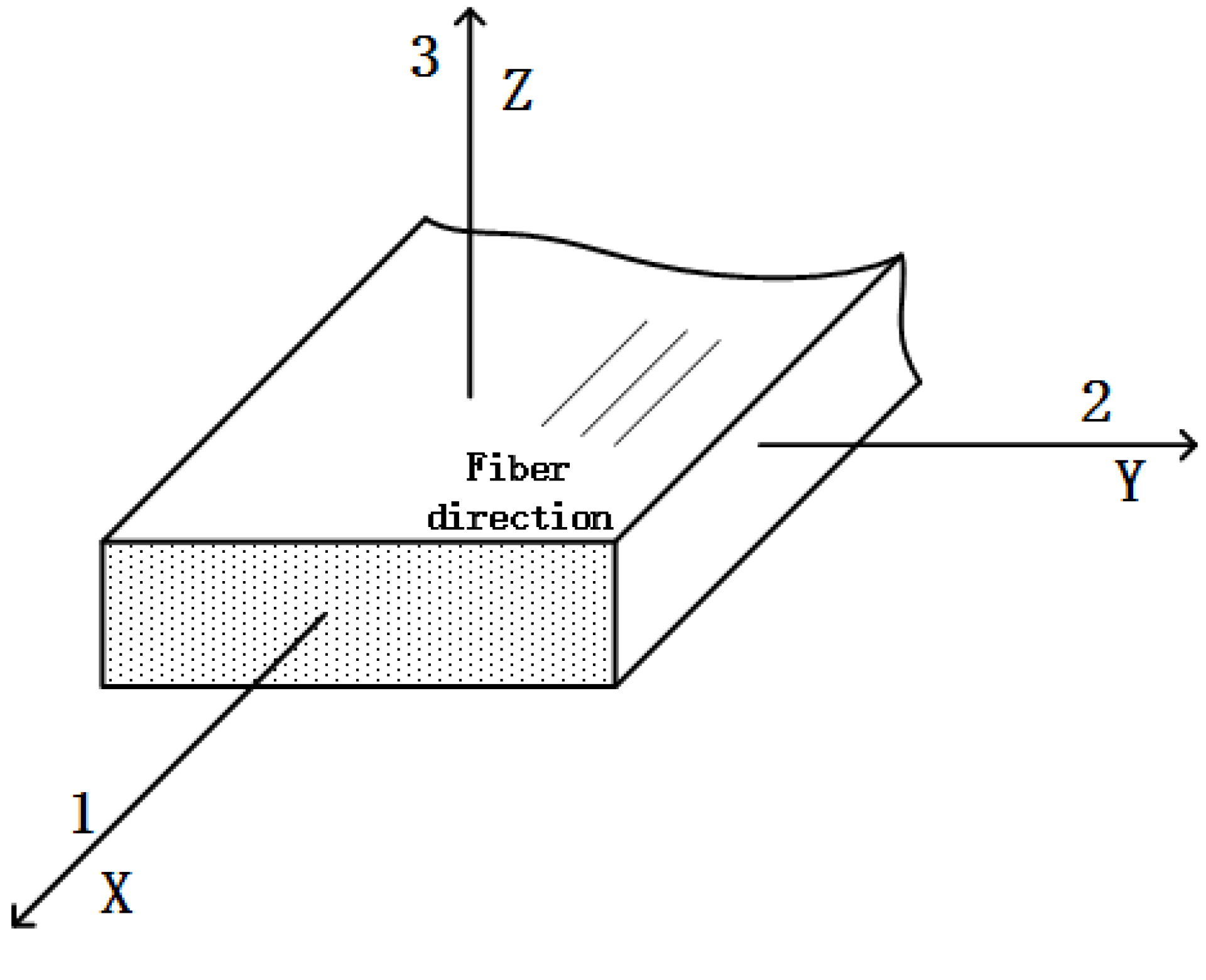
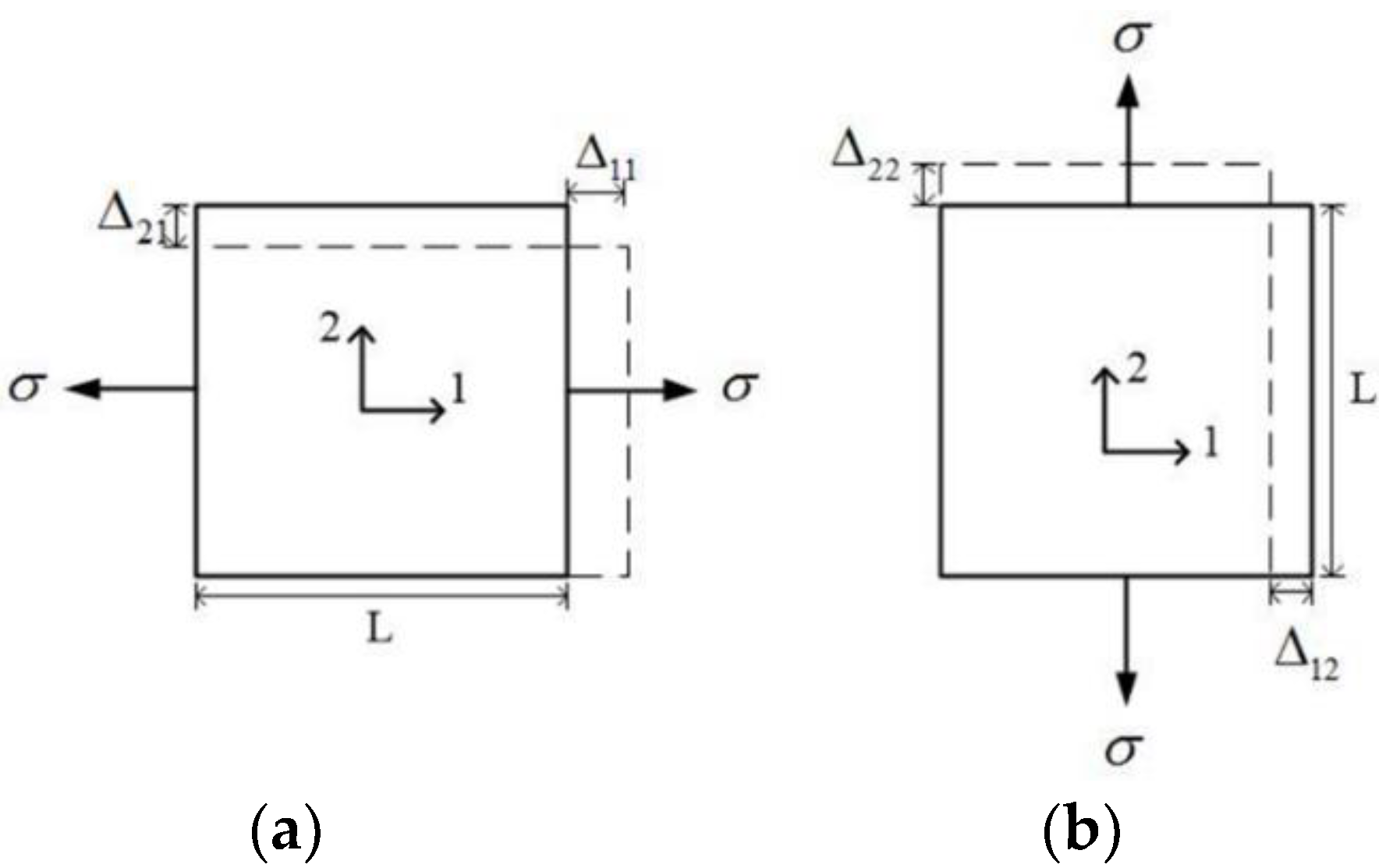





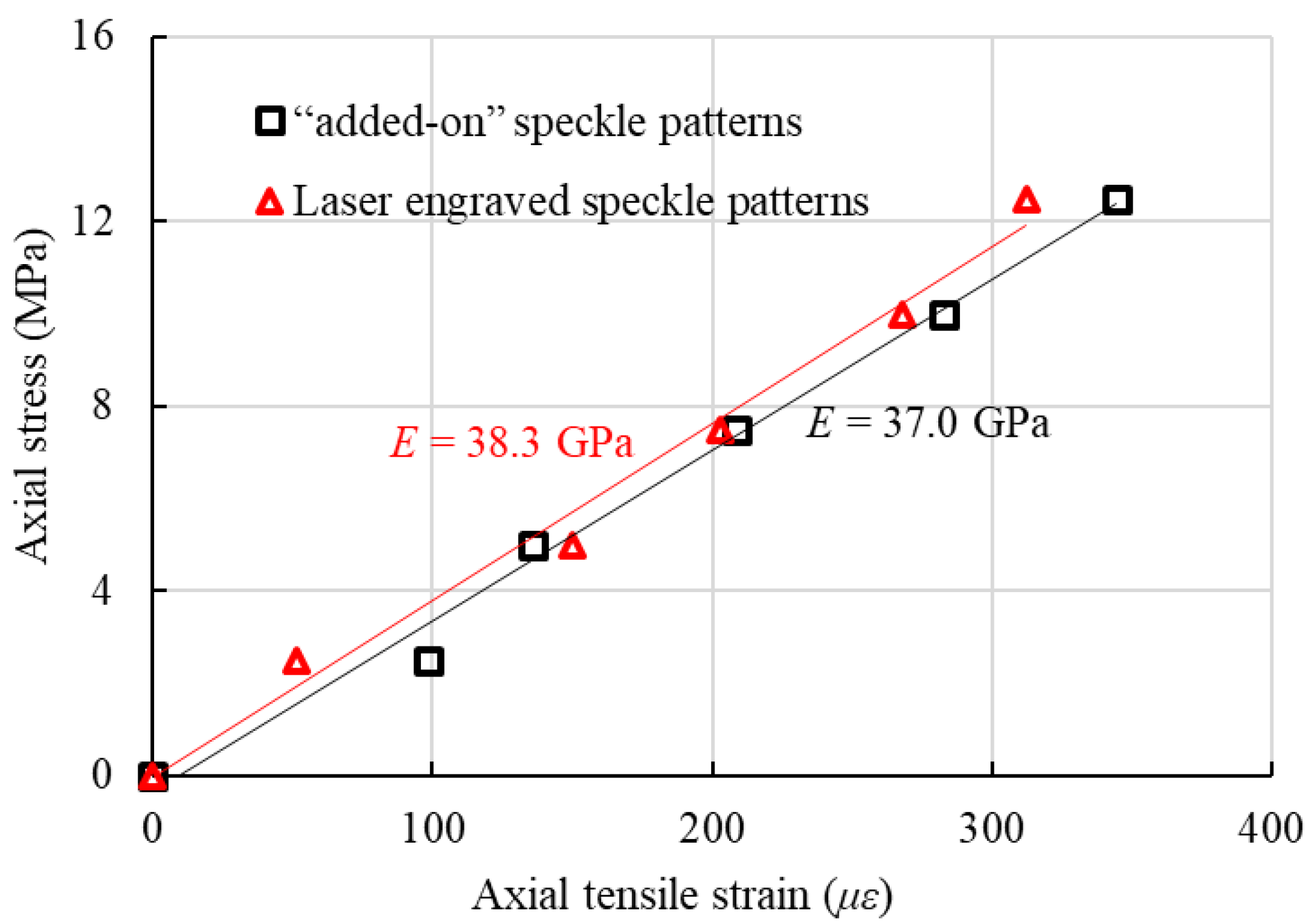

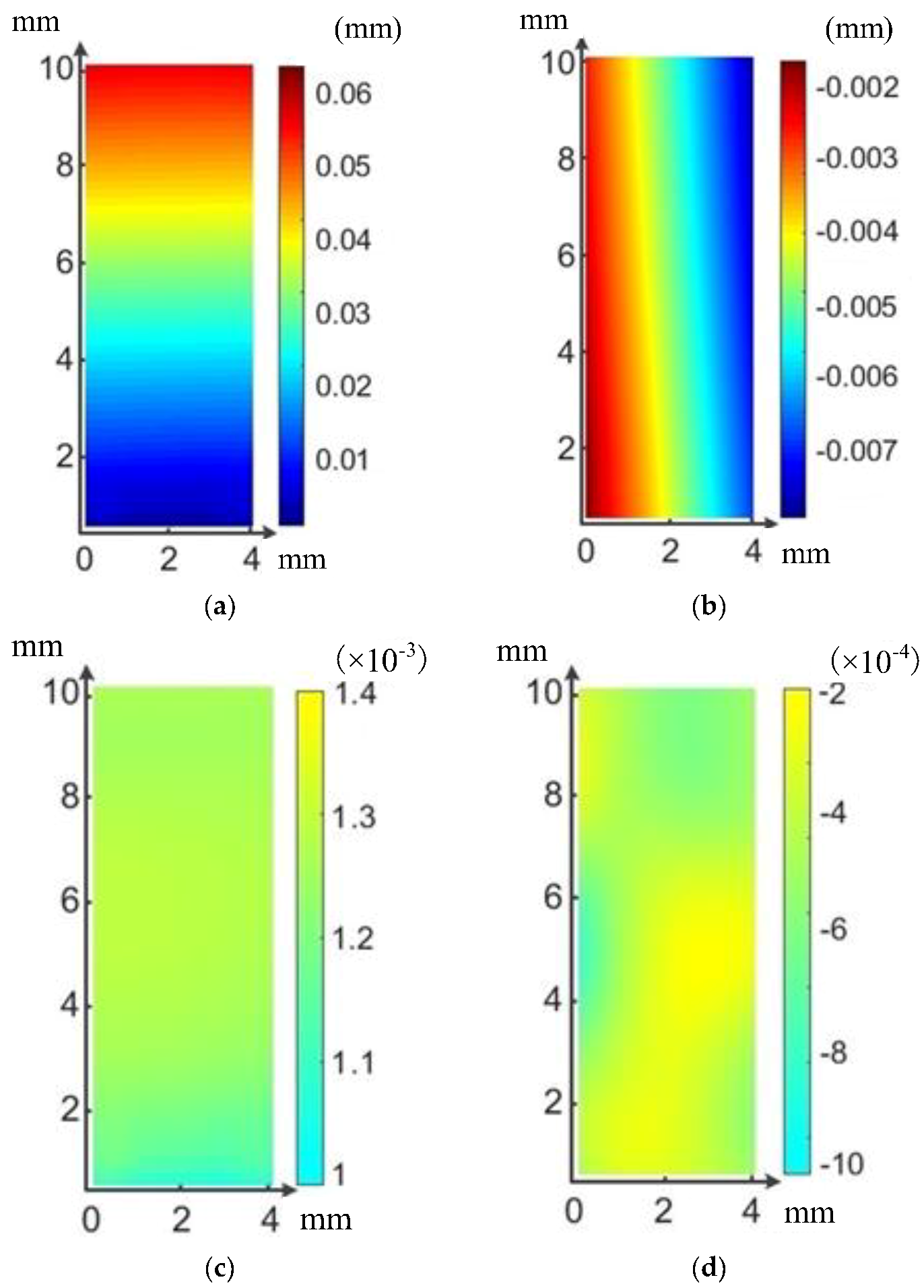
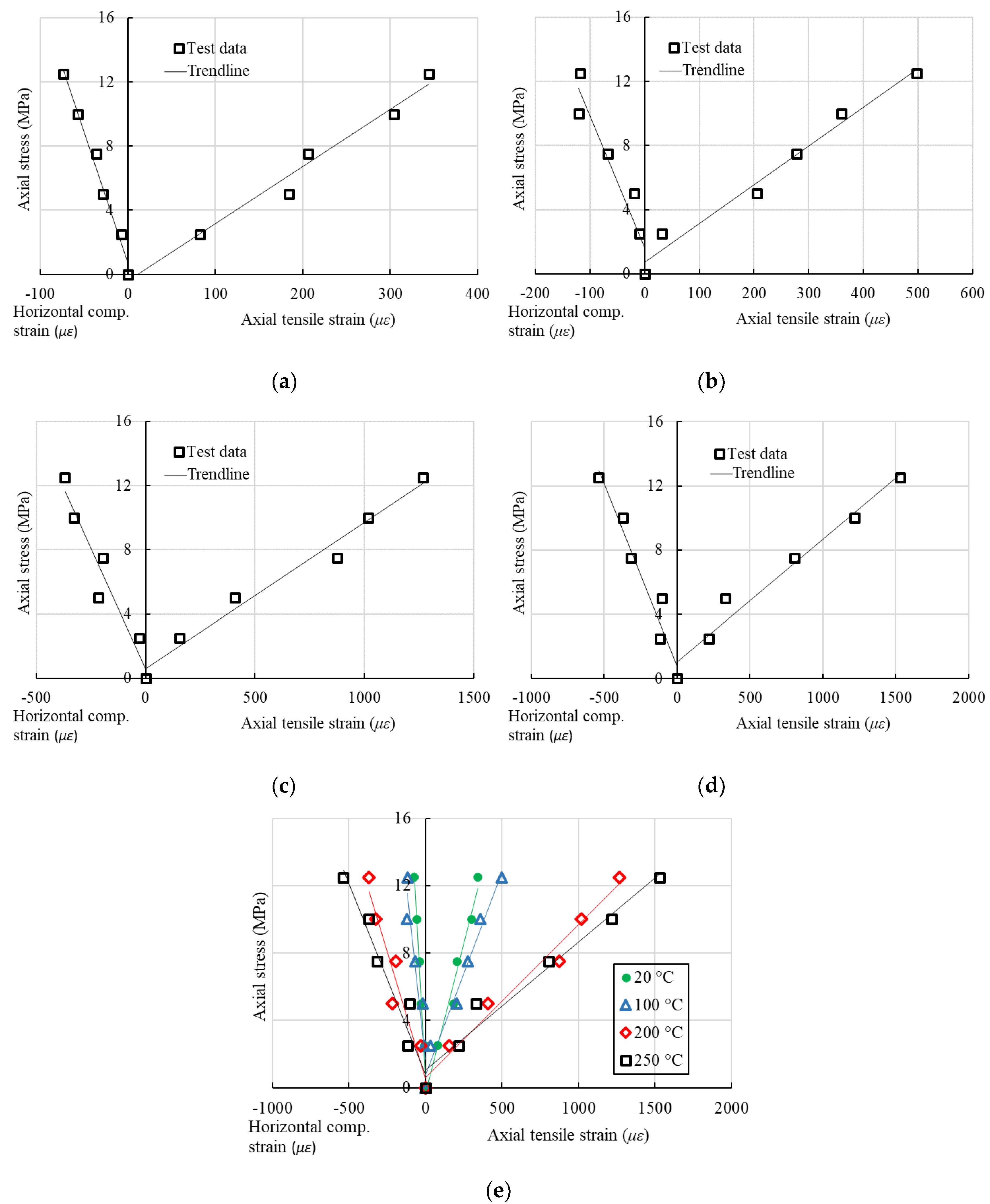

| Temperature (°C) | Load-to-Fiber Angle | Specimen ID | ν21 | E1 (GPa) | E2 (GPa) | E45 (GPa) |
|---|---|---|---|---|---|---|
| 20 | 0° | 1st | 0.215 | 35.532 | - | - |
| 0° | 2nd | 0.249 | 36.955 | - | - | |
| 90° | 1st | - | - | 4.819 | - | |
| 90° | 2nd | - | - | 4.531 | - | |
| 45° | 1st | - | - | - | 5.767 | |
| 45° | 2nd | - | - | - | 6.244 | |
| Standard deviation | 0.024 | 1.006 | 0.204 | 0.337 | ||
| 100 | 0° | 1st | 0.272 | 24.148 | - | - |
| 0° | 2nd | 0.284 | 23.760 | - | - | |
| 90° | 1st | - | - | 2.778 | - | |
| 90° | 2nd | - | - | 2.358 | - | |
| 45° | 1st | - | - | - | 3.223 | |
| 45° | 2nd | - | - | - | 3.056 | |
| Standard deviation | 0.008 | 0.274 | 0.297 | 0.118 | ||
| 200 | 0° | 1st | 0.320 | 9.091 | - | - |
| 0° | 2nd | 0.309 | 10.397 | - | - | |
| 90° | 1st | - | - | 0.962 | - | |
| 90° | 2nd | - | - | 1.056 | - | |
| 45° | 1st | - | - | - | 0.683 | |
| 45° | 2nd | - | - | - | 0.770 | |
| Standard deviation | 0.008 | 0.923 | 0.066 | 0.062 | ||
| 250 | 0° | 1st | 0.335 | 7. 622 | - | - |
| 0° | 2nd | 0.324 | 7. 804 | - | - | |
| 90° | 1st | - | - | 0.639 | - | |
| 90° | 2nd | - | - | 0.604 | - | |
| 45° | 1st | - | - | - | 0.225 | |
| 45° | 2nd | - | - | - | 0.262 | |
| Standard deviation | 0.008 | 0.129 | 0.025 | 0.026 | ||
| Temperature (°C) | ν21 | E1 (GPa) | E2 (GPa) | E45 (GPa) | G12 (GPa) |
|---|---|---|---|---|---|
| 20 | 0.23 | 36.2 | 4.7 | 6.0 | 2.3 |
| 100 | 0.28 | 24.0 | 2.6 | 3.1 | 1.2 |
| 200 | 0.31 | 9.1 | 1.0 | 0.7 | 0.2 |
| 250 | 0.33 | 7.7 | 0.6 | 0.2 | 0.07 |
© 2018 by the authors. Licensee MDPI, Basel, Switzerland. This article is an open access article distributed under the terms and conditions of the Creative Commons Attribution (CC BY) license (http://creativecommons.org/licenses/by/4.0/).
Share and Cite
Hu, Y.-J.; Jiang, C.; Liu, W.; Yu, Q.-Q.; Zhou, Y.-L. Degradation of the In-plane Shear Modulus of Structural BFRP Laminates Due to High Temperature. Sensors 2018, 18, 3361. https://doi.org/10.3390/s18103361
Hu Y-J, Jiang C, Liu W, Yu Q-Q, Zhou Y-L. Degradation of the In-plane Shear Modulus of Structural BFRP Laminates Due to High Temperature. Sensors. 2018; 18(10):3361. https://doi.org/10.3390/s18103361
Chicago/Turabian StyleHu, Yu-Jia, Cheng Jiang, Wei Liu, Qian-Qian Yu, and Yun-Lai Zhou. 2018. "Degradation of the In-plane Shear Modulus of Structural BFRP Laminates Due to High Temperature" Sensors 18, no. 10: 3361. https://doi.org/10.3390/s18103361
APA StyleHu, Y.-J., Jiang, C., Liu, W., Yu, Q.-Q., & Zhou, Y.-L. (2018). Degradation of the In-plane Shear Modulus of Structural BFRP Laminates Due to High Temperature. Sensors, 18(10), 3361. https://doi.org/10.3390/s18103361







